ODP Leg 192: Ontong Java Plateau
- The Largest Igneous Province -
Downhole Logging Summary
Introduction
The Ontong Java Plateau (OJP) near the Solomon Islands in the western Pacific
is the largest igneous province in the world (Fig.1, Fig.
2). Formed about 120 million years ago, it has a surface area of >1.5x106
km2 (roughly the size of Alaska), and a volume of ~5x107
km3. It is generally thought that igneous provinces such as
the OJP were formed during an initial plume-head stage of hot-spot development.
This plume-head model predicts that the plateaus were formed in massive
eruptive outpourings of basaltic magma lasting only a few million years or less, possibly
having major climatic, oceanographic and biospheric impacts. Nearly all
of the large igneous provinces (LIPs) in the oceans today were formed in
the Cretaceous period, suggesting a mode of mass and energy transfer
from the Earth's interior to its surface that differed from the ocean ridge-dominated
mode of the Cenozoic. If, as evidence to date suggests, most of the
OJP was formed in a single volcanic episode lasting only a few million
years, then the magma production rate required for its formation would
have rivalled that of the entire global mid-ocean ridge system at the time. The OJP may therefore represent the largest igneous event of the last 200
million years.
|
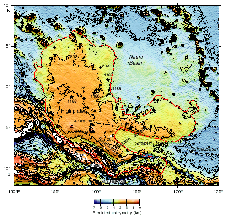
|
Figure 1. Predicted bathymetry of the Ontong Java
Plateau region, showing ODP drill sites.
|
|
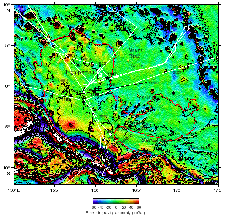
|
Figure 2. Satellite-derived free-air gravity of
the Ontong Java Plateau region, showing ODP drill sites and survey lines
providing seismic control.
|
The OJP's enormous size and thick blanket of marine sediments constitute formidable obstacles to systematic sampling of plateau basalts. An effective sampling strategy in this situation is to begin with a reconnaissance phase of drilling several holes ~100 m into basement in key areas, on the basis of which sites for a small number of deep holes (~1 km) are selected. Prior to Leg 192, the basement of the OJP had been sampled at Deep Sea Drilling Program Site 289 (9-m basement penetration), Ocean Drilling Program (ODP) Sites 803 (26 m) and 807 (149 m), and at outcrops in the Solomon Islands. Leg 192 was designed to complete the reconnaissance phase of OJP drilling, with the principal objectives of determining:
-
The age and duration of emplacement of the plateau
-
The range and diversity of magmatism
-
The eruptive environment and mode of extrusion (sub-aerial or sub-aqueous)
To meet these objectives, the drilling strategy was to recover igneous basement at as many morphologically and tectonically distinct regions of the plateau as possible on one drilling leg, with deeper basement penetration at two sites. As basement penetration was the priority, it was decided to drill ahead (i.e. not core) through the upper part of the sedimentary section at all sites in order to gain basement penetration time. Five sites (1183-1187) were drilled (Fig.1) with igneous basement penetrations of 20 to 217 m. Details of these sites are given in Table 1 from the ODP Leg 192 Preliminary Report.
Downhole Logging
The initial
logging plan for Leg 192 called for wireline logging of two sites:
Site 1183 and the proposed Site OJ-7. This plan had to be revised during
the cruise when the hole collapsed during drilling at the former site,
and when ODP/TAMU and the U.S. State Department were unable to obtain permission
from the Solomon Islands to drill at the second site. Mechanical failures and time constraints prevented logging
at other sites. Only one hole, Hole 1186A, was therefore logged.
Site 1186
Site 1186 is located on the eastern slope of the main Ontong Java Plateau,
roughly halfway between the crest and the eastern edge of the main plateau
(Fig.1, Fig.
2). It is 206 km west of Site 1185, 319 km east of Site 1183, and 149
km east-southeast of DSDP Site 289. Very different volcanic stratigraphy
observed in cores at Sites 1183 and 1185 led to the selection of Site 1186
during the cruise, in order to sample the basement stratigraphy at an intermediate
location.
Approximately 12 km east-northeast of Site 1186 seismic-reflection data
show a small body, interpreted to be an igneous intrusion or small volcanic
cone, rising into the sedimentary sequence ~500 m above the surrounding
acoustic basement. Projecting from this body toward the drill site is a
package of high-amplitude and continuous reflections that was hypothesized
to represent a sill, lava flow, volcaniclastic sediments, or pelagic sediments
altered by hydrothermal fluids derived from the igneous body (Fig.
3). A secondary reason for selecting Site 1186 was to core this
reflection package. If it proved to represent a sill or lava flow, it would
provide information on what is thought to be late-stage magmatism seen
in seismic reflection records across much of the high plateau.
|
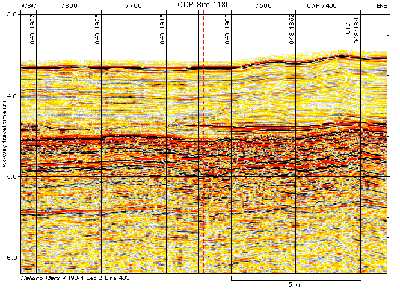
|
Figure 3. Hakuho Maru multichannel seismic reflection
profile across Site 1186
Logging Operations
Prior to logging at Site 1186, the hole was flushed with sepiolite. The
usual "wiper trip" with the drill string was not conducted because of the
softness of much of the sedimentary column. The drill string was then retracted
to 123 mbsf for logging. Throughout logging operations, sea conditions
were extremely calm with a swell of 1-2 m, and the wireline heave compensator
was working normally. All logging runs were made at 274 m/hr, the standard
rate used for high-resolution logs.
Site 1186 was logged using two tool strings. The first run was the geophysical tool string, which measures electrical resistivity, neutron porosity, density, natural gamma radiation and temperature (this tool string is also known as the "triple combo"). The hole was logged from 1034 mbsf to 679 mbsf, slightly above the top of the cored interval. The tool string was then retrieved to 163 mbsf, from which point logging was resumed up through the pipe to 16 m above the seafloor, providing a reference point at the mudline for depth matching of log data to cores. The second logging run was with the Formation MicroScanner (FMS)/Sonic tool string, which provides electrical images of the borehole walls, and compressional and shear sonic velocities. An initial pass starting at 1033 mbsf was aborted at 948 mbsf when communication with the toolstring was lost and the system had to be reinitialized. Logging proceeded upwards from 1033 to 690 mbsf on the second FMS/Sonic pass, and from 1033 to 975 mbsf on the third pass. The logging activities are summarized in Table
2. Further information on the tool strings used may be found in the
technology section of the Online Log Database (LogDB)
.
Data Quality
The Spherically-Focussed Laterolog (SFLU) on the Dual Induction Tool (DIT-E)
of the geophysical toolstring, which makes high resolution measurements
of electrical conductivity, did not function properly. As can be seen in Fig.
4, the caliper log, which measures borehole diameter, shows that the
hole was washed out beyond the caliper range of 19" from 810 to 932 mbsf.
This interval corresponds precisely to the nannofossil chalk Subunit IIIA,
identified from cores. As the FMS and nuclear tools must be in contact
with the borehole wall to make accurate measurements, borehole diameter
and smoothness are the primary factors influencing data quality. Accordingly,
the logs are not considered reliable in the nannofossil chalk subunit,
but are good throughout the rest of the logged interval and correspond
closely with lithologies observed in the cores. Accurate depth matching
between individual logging passes and between logging data and cores was
problematic, as the depth offsets observed at reference points such as
the mudline, the bottom of the pipe, the sediment/basement contact and
various lithological markers showed inconsistencies with driller's depths
and between logging runs of up to 4 m. Possible causes of this are cable
stretch, incomplete heave compensation, and errors in driller's depths.
Results
Sedimentary Section
-
The most notable feature on the logging data in Sedimentary Unit II, in
which core recovery was very poor, is a thick accumulation of chert between
724 and 728 mbsf. The signature of this layer is evident on the velocity,
electrical resistivity, density and porosity logs (Fig.
4), and it can be clearly seen in the FMS images (Fig.
5). This layer is thought to be the cause of the strong seismic reflection
noted previously in the sedimentary section at 4.37 s two-way traveltime
(Fig.
3). Thinner interbedded chert and limestone layers are evident on FMS
images throughout Unit II, and on porosity and density logs. The top of
the limestone of Subunit IIIB is marked by a peak in gamma-ray emission
at 933 mbsf, which may indicate an accumulation of ash or volcaniclastic
material at the subunit boundary. Another gamma peak occurs in the
middle of Subunit IIIB at 953 mbsf. Comparison with cores suggests that
this peak may mark the break between the upper and the lower Albian. FMS
images show regular and tightly banded layers throughout this subunit (Fig.
6).
|

|
Figure 4. Composite of wireline logs compared
with core-derived lithostratigraphy in sediment column
|

|
Figure 5. FMS image (from 721 to 731 mbsf) displaying chert
horizons within Paleocene-Eocene limestone of lithologic Unit II.
|
|
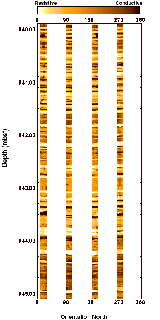
|
Figure 6. FMS images (940 to 945 mbsf) showing
well-laminated Aptian-Albian limestone of lithologic Unit III, Subunit
IIIB.
|
Basement
The sediment-basement contact is clearly visible on FMS images (Fig.
7). A thin conductive layer immediately overlying the basement
corresponds to brown claystone observed in the core. Microresistivity in
the upper 2 m of basalt is the highest observed in the entire basement
section, which may reflect alteration and cementation of pores as a result
of seafloor weathering. The major basement units identified from the cores
are apparent in both conventional logs (Fig.
8) and FMS images. A gradation of physical properties is apparent in
the conventional logs across unit boundaries. Intervals of rapid physical
property variations can be seen between massive basalt units. FMS images
of these sections show pillows with interpillow sediments (Fig.
9). It is noteworthy that pillow-like features are observed at the
bases of massive units as well as at their tops. Within the massive basalt
of basement Unit 4, microresistivity variations are observed in the FMS
images that accord closely with variations of grain size observed in the
cores, demonstrating the sensitivity of electrical conductivity measurements
to such textural variations.
|
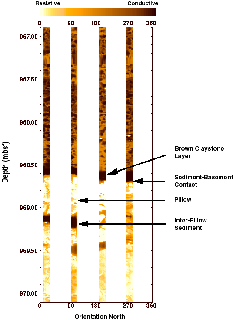
|
Figure 7. FMS image (from 967 to 970 mbsf) showing
the contact between Aptian-Albian limestone of lithologic Unit III (Subunit
IIIB) and basalt of basement Unit 1.
|
|
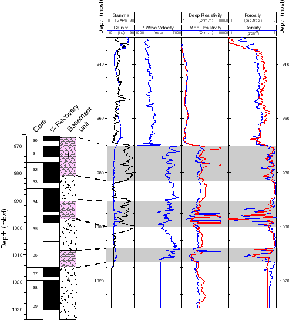
|
Figure 8. Composite of wireline logs in lowermost
sediments and igneous basement compared with core-derived lithostratigraphy
|
|
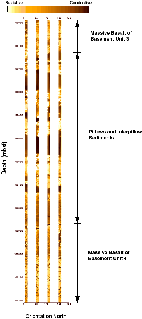
|
Figure 9. FMS image (990 to 1002 mbsf) showing
pillows and interpillow sediments between massive basement Units 2 and
3.
|
|
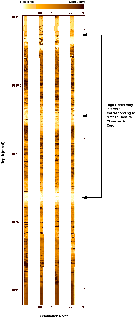
|
Figure 10. FMS image (from 1011 to 1032 mbsf) of massive basalt
in basement Unit 4.
|
ODP Staff Logging Scientist :
Graeme Cairns, UBO, UMR 6538, IUEM, Place Nicolas Copernic, 29280 Plouzane,
France.
JOIDES Logging Scientist :
Millard F. Coffin, Institute for Geophysics, University of Texas at Austin,
Building 600, 4412 Spicewood Springs Road, Austin TX 78759-8500, USA